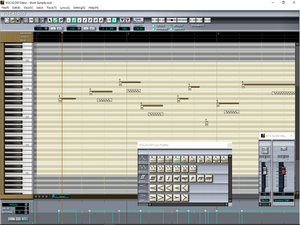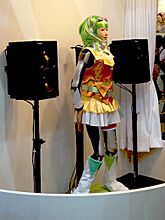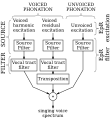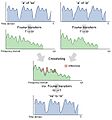Vocaloid facts for kids

The screen of Vocaloid 6
|
|
| Developer(s) | Yamaha Corporation |
|---|---|
| Initial release | January 15, 2004 |
| Stable release |
Vocaloid 6 / October 13, 2022
|
| Operating system | Microsoft Windows macOS iOS (Mobile Vocaloid Editor, Japan only) |
| Available in | Japanese, English, Korean, Spanish, Chinese, Catalan |
| Type | Voice synthesizer software |
| License | Proprietary |
Vocaloid (ボーカロイド, Bōkaroido) is a special computer program that lets you create songs with a singing voice. It is a voice synthesizer, which means it can create human-like sounds. Think of it as a musical instrument, but instead of playing piano or guitar sounds, it plays singing voices.
To make a song, you type in the words (lyrics) and the tune (melody). The software then "sings" your song. It does this by using a huge library of voice recordings from real singers. Each Vocaloid has its own unique voice and is often represented by a character, like an anime-style avatar. These characters are sometimes called virtual idols.
Many people, from professional musicians to hobbyists, use Vocaloid to create music. Some of the most famous virtual idols, like Hatsune Miku, have become so popular that they even perform in live concerts as amazing on-stage projections.
Contents
How Does Vocaloid Work?
Vocaloid technology works by piecing together small bits of human voices that have been recorded. These recordings, called voicebanks or singer libraries, are made by sampling the voices of real actors and singers.
To create a song, a user works with a screen that looks like a piano keyboard, called a "piano roll." Here's how it works:
- Melody: The user places notes on the piano roll to create the tune of the song.
- Lyrics: For each note, the user types in the word or syllable they want the Vocaloid to sing.
- Customization: Users can change many things to make the voice sound more expressive. They can add effects like vibrato (a slight wavering in pitch), change the tone of the voice, and adjust how strongly certain words are pronounced.
The software then connects all these sounds smoothly to create a complete singing performance. While it's designed for singing, it's not meant for regular text-to-speech, like having a computer read a book out loud.
The Evolution of Vocaloid
Vocaloid has gone through many updates since it was first created. Each new version has made the voices sound more realistic and added new features for music creators.
Vocaloid and Vocaloid 2
The first version of Vocaloid was released in 2004. The first English Vocaloids were named Leon and Lola. The first Japanese ones were Meiko and Kaito.
Vocaloid 2, released in 2007, was a huge step forward. It had a brand new engine that made the voices sound much better. This is the version that introduced Hatsune Miku, who quickly became the most famous Vocaloid in the world and helped make the software incredibly popular.
Vocaloid 3 and 4
Vocaloid 3 came out in 2011. A big feature of this version was that it added support for more languages. Now, Vocaloids could sing in Spanish, Chinese, and Korean, opening up the software to creators all over the world.
Vocaloid 4, released in 2015, gave musicians even more tools. It introduced features like "growl," which allowed for rougher, more powerful-sounding vocals, and "cross-synthesis," which let users blend two different voicebanks together to create new sounds.
Vocaloid 5 and 6
Released in 2018, Vocaloid 5 focused on making the software easier to use. It came with a new look and features that helped producers create songs more quickly.
Vocaloid 6 was released in 2022 and introduced a new technology called Vocaloid:AI. This uses artificial intelligence to make the singing voices sound incredibly natural and human-like. It can even recreate a singing style from an audio recording, giving creators amazing new possibilities.
From Software to Superstars
Although Vocaloid is a software product, its characters have become famous in their own right. The companies that create Vocaloids market them as individual artists, each with a unique design and personality.
Virtual Idol Concerts
One of the most exciting parts of Vocaloid culture is the live concerts. Using high-tech projection, characters like Hatsune Miku can appear on a transparent screen on stage, looking like they are really there. They sing and dance for thousands of fans, backed by a live band.
These concerts started in Japan but have since become a worldwide phenomenon, with tours in North America, Europe, and Asia. This has allowed fans from all over the globe to see their favorite virtual idols perform live.
Vocaloid in Pop Culture
Vocaloid characters appear in many places outside of music.
- Racing: In Japan, the Good Smile Racing team competes in the Super GT car racing series with cars decorated with artwork of Hatsune Miku and other Vocaloids.
- Games and Manga: Many video games have been made featuring Vocaloid characters, such as the popular Hatsune Miku: Project DIVA series by Sega. There are also official manga series based on the characters.
- Merchandise: Fans can buy all sorts of merchandise, including figures, plush dolls, and clothing of their favorite Vocaloids.
A Community of Creators
The success of Vocaloid is largely thanks to its amazing community of fans and creators.
The Role of the Internet
When Vocaloid 2 was released, the Japanese video-sharing website Niconico played a huge role in its popularity. Users, often called "Vocaloid-P" (P for producer), would create original songs and upload them.
If a song became popular, other fans would create art, animations, and dance videos for it. This created a cycle of creativity where one person's song could inspire hundreds of other fan works. Today, this community is active on websites like YouTube as well.
Vocaloid in Space!
In 2010, fans successfully petitioned the Japanese space agency, JAXA, to include images of Hatsune Miku on the Akatsuki space probe. The probe was sent to study the planet Venus, carrying three small aluminum plates with Miku's picture on them.
More Than Just Software
The Vocaloid community has created other tools to help bring the characters to life. One of the most famous is MikuMikuDance (MMD). MMD is a free 3D animation program that lets users create their own animated music videos featuring Vocaloid characters. This program helped the fan community grow even bigger by making it easy for anyone to create amazing 3D videos.
There are also mobile app versions of Vocaloid, allowing people to create music on their phones and tablets.
Rules for Using Vocaloid
The companies that create Vocaloids have special rules for how their characters can be used. For fan-made, non-commercial projects (like art you post online for fun), people are usually free to use the characters as long as they give credit to the original creators. This is thanks to a license called Creative Commons.
However, for commercial products (anything you plan to sell), you need to get permission from the company that owns the character. The companies also prefer to keep the characters out of political topics to ensure they remain fun for everyone.
Images for kids
See also
 In Spanish: Vocaloid para niños
In Spanish: Vocaloid para niños
- Auto-Tune
- Cantor
- CeVIO
- Computer music
- Dōjin music
- Hatsune Miku
- List of Vocaloid products
- Macne series
- Kagerou Project
- Nyan Cat
- Reol
- Software synthesizer
- Speech synthesis
- UTAU
- Virtual idol
- Voiceroid











